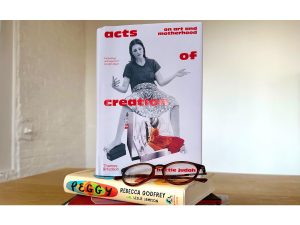‣ It’s been a big year for Venezuelan ceramicist and painter Magdalena Suarez Frimkess, who celebrated her 95th birthday and just got her first museum retrospective. For the Los Angeles Times, David A. Keeps chats with the indefatigable artist and those she’s influenced:
During her residency, she met Michael Frimkess, a Los Angeles potter who had studied with ceramic revolutionary Peter Voulkos at what would become the Otis College of Art and Design. She married Michael in Los Angeles in 1964, and by 1971, when he was diagnosed with multiple sclerosis, they had set up shop on Abbot Kinney in Venice.
“I have to blame Michael’s family,” she recalls. “His father rented this place that was very cheap in those days and put us to work, and the rest is history. I refused to get into the pottery wheel, that was his thing.”
It was the heyday of studio pottery, and Michael created the pots she could decorate, while she also kept the house, cared for their daughter, Luisa, sold clothes she designed in the front of the studio and made her own work from scraps of clay.
“Magdalena told me it was a boys’ club back then,” says Conder, founder of the Chinatown gallery South Willard, an early supporter of Suarez Frimkess. “And her work was free of the concerns of the art market, so she could just be herself.”
‣ Several Black artists, archaeologists, and divers are transforming the ocean by approaching it as a graveyard, a site of the Middle Passage, and a possible space for healing. For Atmos, Omnia Saed writes:
“As a scholar engaged in this work, and as one of the very few Black archaeologists in the world—especially those of us who dive and study the Black Atlantic—I can’t think of a single one of us who doesn’t speak about how deeply this work is connected to our own ancestral practices. It’s about paying homage to those who came before us and seeking justice for those whose voices and stories have been reduced to mere commodities.”
In June, Miller helped lead the second session of the Slave Wrecks Project Academy in Senegal, where students dove off the coast of Gorée Island, once the largest slave-trading hub on the African coast.
“People were tossed overboard like refuse. Many died on the voyage and became a permanent part of the sea. So, when we excavate, visit, and monitor these shipwrecks, I don’t think many people realize that we’re standing in a graveyard,” she said.
Part of Miller’s practice, as she describes it, is tending to these graveyards—preserving the sense of space. The ships and the artifacts are important, but her divers are urged to ask themselves: How was this space used? How do we memorialize it? And what do you see?
‣ The Human Rights Watch published a must-read report on the Israeli military’s torture of Palestinian healthcare workers, 10 months into the ongoing bombing of Gaza and the destruction of its hospitals:
From March to June 2024, Human Rights Watch interviewed eight Palestinian healthcare workers who were taken by the Israeli military from Gaza between November and December 2023 and detained without charge for between seven days and five months. Six were detained at work following Israeli sieges of hospitals or during hospital evacuations that they said had been coordinated with the Israeli military. None of the healthcare workers said they were ever informed of the reason for their detention or charged with an offense. Human Rights Watch also spoke with seven people who witnessed Israeli soldiers detaining healthcare workers carrying out their duties.
Human Rights Watch sent a letter to the Israeli military and Israeli Prison Services with the preliminary findings on August 13 but has not received a response.
‣ Percival Everett’s novel James, which narrates Huckleberry Finn from the perspective of Jim, is far more than a typical literary retelling. Critic Omari Weekes explores the transformative story in a review for the Nation:
Much of James’s comedy derives from this time-tested dynamic: Black people capitalizing on white people’s insistence on the facile nature of Black imagination. Everett impugns the false notion of Black inferiority by reworking Negro dialect, the often stigmatized form of English commonly attributed to the enslaved, into a tool of cunning subterfuge rather than communication. For the novel, the deliberate systematization of Negro dialect into a language with its own rigid internal logics that must be learned much as one would a foreign tongue helps to conceal Black genius and offers the enslaved some safety from oppressors who are assured in their supremacy.
Readers are made privy to the extent to which code switching is necessary for Black survival during a dialect lesson early in James. Jim, still living on a plantation in Twain’s hometown with his wife and daughter, engages a group of children in language-learning exercises, correcting their grammar and explaining why such a form of speech must be studied when they already know English, telling the youngsters: “White folks expect us to sound a certain way and it can only help if we don’t disappoint them.” When Jim asks the children how they would inform a white woman that her kitchen is on fire, he notes that the correct answer is “Lawdy, missum! Looky dere” rather than simply “Fire, fire.” The former locution is proper because, as Jim’s daughter understands, “We must let the whites be the ones who name the trouble.” Why? “Because they need to know everything before us,” another girl responds. “Because they need to name everything.”
‣ Anyone subjected to the dreaded psychological “marshmallow test” for measuring delayed gratification won’t be surprised to learn that it’s laden with biases and harmful assumptions. Carolyn Y. Johnson explains for the Washington Post:
Other studies began to poke holes in hallmark findings. Yuko Munakata, a developmental psychologist at the University of California at Davis, conducted a variation on the Marshmallow Test that showed that children’s ability to wait for a treat wasn’t like a muscle that was strong or weak, but changed markedly depending on the context. Japanese children, culturally accustomed to waiting for food, were able to hold out for a food reward, but not for a present. American schoolchildren, on the other hand, used to waiting to unwrap gifts under a Christmas tree or at a birthday party, were able to wait for a gift, but not food.
Miller-Cotto, who is Black, wondered whether even the way the tests were administered could influence how children performed. Being taken into a quiet room by a White researcher to solve a set of puzzles and games might be a novel, uncomfortable experience for Black or Latino children. With Andrew Ribner at Chatham University, she is conducting a set of experiments to test whether matching the racial identity of the researcher to the child or changing the location where a test is given changes children’s performance.
‣ With “demure autumn” almost upon us, Them‘s Quispe López considers the significance for trans people of the now-iconic catchphrase coined by Jools Lebron (who, by the way, can now fund her gender-affirming care thanks to her viral videos):
But sometimes demure is juxtaposed with objectively “undemure” activities like taking shots in airport bars and going hungover to CVS. Lebron explains the ironic humor behind demure to her followers as a satire of sincere TikToks policing women on being classy and “mindful” as to why they were invited to the section. There’s a tongue-in-cheek levity to Lebron telling her viewers how to be demure. Her point is that anything you say is demure, or can be demure. That’s the beauty of it.
It’s no surprise that such innovation, irony, and subtext could only come from the likes of a transfemme influencer. Lebron, much like internet dolls Devin Halbal, Selyna Brillare, or Blizzy McGuire, has reached far beyond TikTok itself in this current viral flashpoint. And despite some controversy about who started the trend first, this is undoubtedly a moment for the dolls to finally get their long-deserved flowers in cultural creation and ingenuity.
‣ TikToker Mochi Hanfu serving and educating in this video on reclaiming traditional Chinese qipaos:
‣ It’s always a slippery slope with TSA …:
‣ Our friendly neighborhood nonprofit boss is back just in time for Labor Day — or as she calls it, “Labor” Day:
‣ Sister Minnie is officially the internet’s favorite cat:
Required Reading is published every Thursday afternoon, and it is comprised of a short list of art-related links to long-form articles, videos, blog posts, or photo essays worth a second look.




